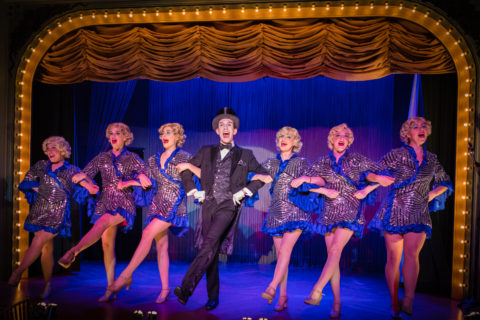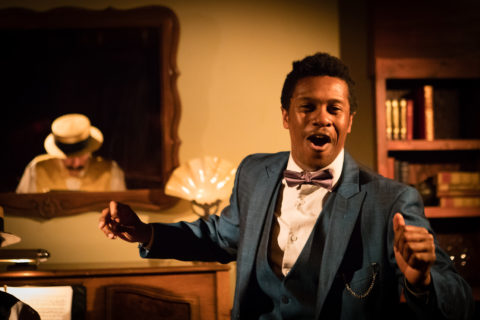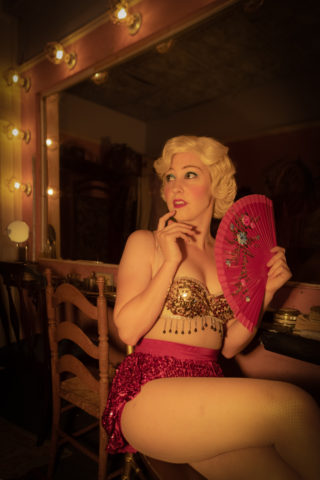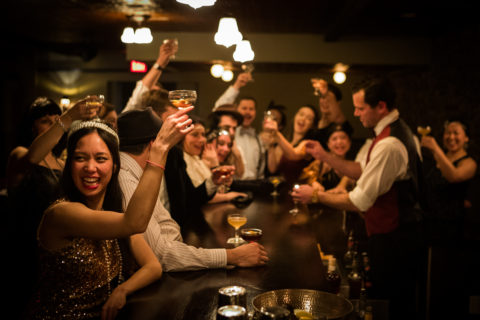
If you’ve never been to The Speakeasy, its hard to know what to expect. There are charming surprises around every corner of its gorgeous underground sprawl. Bar fights. Romances. Song and dance. Baggy pants comedy. The busboy in his skivvies.
But its important to know what you shouldn’t expect: In mixing up an effervescent hybrid of theater, nightclub, costume party and MMPORG, this production delivers more than the sum of its parts without hewing to what you might anticipate from the of any one of them. Its definitely more of a playroom than a play. (Patrons dress nattily, blending in with cast members. Early on it can be difficult to tell who’s who).
As Speakeasy impresario and co-director Nick Olivero told me before my own first visit last week, the experience is sui generis. Chatting in a vernacular as distinctive as the Prohibition-era lingo yakked by the Speakeasy’s chorus girls and rum runners, Olivero says he doesn’t want you to feel like “Hey, there wasn’t enough singing in that ballet!” or “This chocolate cake doesn’t taste enough like banana cream pie.” Attendees should go with the bootleg flow and leave their preconceptions at the door.
Also, their mobiles. To me, the most revelatory pleasure of this night on the town, set in the Roaring Twenties, turned out to be the strict prohibition of cellphones. They’re locked into security pouches as you enter and not released until you leave around three hours later. Sure, its era-appropriate, but its also a means of deepening your immersion in the evening.
 Unencumbered of the ability to share selfies, scroll through headlines or crush candy at every moment, you notice the stylish details of wandering characters’ socks and neckties. You let yourself sink in to the husky, double entendre soaked tones of saloon singer Velma (Em Lea Reaves, one of the 26-person cast’s standout performers). You eavesdrop on conversations between barflies and bootleggers. And you realize how the ticklish joys of eavesdropping—and people watching—have become much rarer endeavors in our digitally-mediated present day.
Unencumbered of the ability to share selfies, scroll through headlines or crush candy at every moment, you notice the stylish details of wandering characters’ socks and neckties. You let yourself sink in to the husky, double entendre soaked tones of saloon singer Velma (Em Lea Reaves, one of the 26-person cast’s standout performers). You eavesdrop on conversations between barflies and bootleggers. And you realize how the ticklish joys of eavesdropping—and people watching—have become much rarer endeavors in our digitally-mediated present day.
The Speakeasy gifts you with a boozy opportunity to be here now. Of course, “here” is both a posh multi-chambered labyrinth and a sub-basement of China Live, and “now” is tonight and 1923. But hey, its San Francisco—mind-bending metaphysics are always in style.
 To me, the dizzy convolution of being hyper-present in an ultra-realistically rendered fictional setting is plenty reason to send my philosophically-bent artpals to “The Speakeasy.” But of course, if that were that its primary appeal, the show wouldn’t be going into a remarkable third year of frequently sold-out performances with ticket prices that start at $59 before you even open a bar tab. So far, over 50,000 people have stepped through the doors of dusty clock repair shop and abandoned Chinese laundry that serve as portals to this gin-soaked wonderland, to the tune of over $5 million in ticket sales.
To me, the dizzy convolution of being hyper-present in an ultra-realistically rendered fictional setting is plenty reason to send my philosophically-bent artpals to “The Speakeasy.” But of course, if that were that its primary appeal, the show wouldn’t be going into a remarkable third year of frequently sold-out performances with ticket prices that start at $59 before you even open a bar tab. So far, over 50,000 people have stepped through the doors of dusty clock repair shop and abandoned Chinese laundry that serve as portals to this gin-soaked wonderland, to the tune of over $5 million in ticket sales.
Olivero and his colleagues have struck gold in striking a happy balance between ambitious art making and mass appeal.
“I am a gateway drug, like “Hamilton”” Olivero says, half-joking. “Look, my background is non-profit theater, but lots of the people who come to “The Speakeasy” would never describe themselves as theater people. We get birthday parties, bachelorette parties. 80% of the audience is on dates.”
Olivero says that for the show’s refreshed iteration, called “The Age of Scofflaws”, which opened earlier this month, he trimmed approximately a quarter of the 1500 pages of dialogue that characters in the show speak as they and the audience move throughout the period-decorated rooms that make up “The Speakeasy”‘s 9,000 square foot space (Among them a saloon with live music, a casino where guests can gamble with play money, a multi-tiered showroom with bandstand and stage, and backstage dressing area that voyeurs can observe through a one-way mirror).
 “Over time, I realized that I’d overwritten. People are coming to be with each other and have fun. There needed to be more breathing room between the dramatic moments, so people could talk to the friends they came with and not have to keep quiet in order to hear everything,” Olivero says. “It’s turned out great. The audience gets much rowdier enjoying themselves, and because there’s room for that, they’re more willing to pause and pay attention when a scene is happening.”
“Over time, I realized that I’d overwritten. People are coming to be with each other and have fun. There needed to be more breathing room between the dramatic moments, so people could talk to the friends they came with and not have to keep quiet in order to hear everything,” Olivero says. “It’s turned out great. The audience gets much rowdier enjoying themselves, and because there’s room for that, they’re more willing to pause and pay attention when a scene is happening.”
The balance felt ideal to me. In addition to having my intellect tickled by the entire, brilliantly executed conceit, I thoroughly enjoyed the showroom fan dances, the murmured rumors of a potential raid, the budding romance between a bouncer and a cocktail waitress, and several run ins with the simultaneously corny and creepy comedian, Eddie (Burt Nesor, reminiscent of Caesar Romero’s “Batman” Joker). But what I enjoyed the most was the sense of being on an unexpected little vacation with my partner; relaxing with a few drinks, taking in the scenery and sharing our observations. With nary a glance at our phones.
Originally published in the Bay Area Reporter
